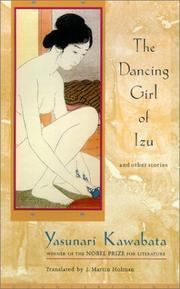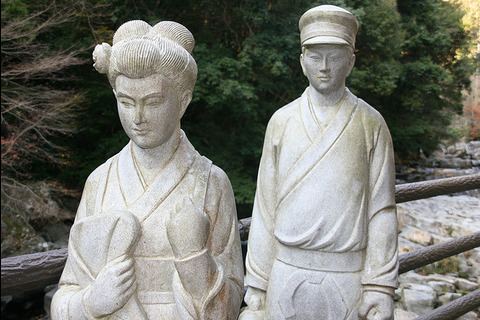Author Country Japan Genre(s) Short story | Language Japanese | |
 | ||
Translator E. Seidensticker (1955);J. Martin Holman (1998) | ||
"The Dancing Girl of Izu" or "The Izu Dancer" (伊豆の踊子, Izu no odoriko) is a 1926 short story by the Japanese writer and Nobel Prize winner Yasunari Kawabata. The short story was first translated into English by Edward Seidensticker and published in an abridged form as "The Izu Dancer" in The Atlantic Monthly in 1955. A complete English translation of the story appeared in 1998.
Contents
Kawabata's "The Izu Dancer" represents a lyrical and elegiac memory of early love. The story is well known in Japan, and, today, part of the story's name, Odoriko (which means "dancing girl") is used as the name of express trains to the Izu area.

Plot
"The Dancing Girl of Izu" tells the story of the interactions between a young male student from Tokyo, and a small group of travelling performers from nearby Oshima island whom he meets while touring the Izu Peninsula. The student sees the group several times and focuses on the beauty of the youngest looking dancer carrying a large drum. He considers how being on the same road as these travelling performers was exciting. Later, he encounters them again at a tea house, but upon hearing that they were leaving for the next town, he struggles with the thought of chasing after them.
Upon catching up with the group, he acts inconspicuously as he passes them on the trail. Much to his relief, the only male in the group, Eikichi, suddenly strikes up a conversation with the student, giving him a reason to keep pace with the travellers. During the trip, he takes a liking to the young dancer that he saw earlier, because of her refreshing and naïve character. He quickly befriends Eikichi, and follows the group until they arrive at an old inn. However, much to his disappointment, Eikichi insists that he stay at a better inn, because he saw the student as someone of higher status. Later that night, he hears the performers putting on a show at a nearby restaurant, and recognizes the distinct sound of the young dancer’s drum. He listens intently to the sound of her drum, and convinces himself that after they are finished performing at the party they will come visit him. However, he becomes very restless during the night when they do not meet him until the following morning.
Eikichi invites him to a nearby public bath to relax and share stories. To his surprise, when he sees the young women playing in the adjacent river, he realizes that the girl he was developing feelings for was much younger than he had originally perceived. Upon understanding his mistake, he felt the burden of his infatuation disappear and subsequently breaks into a fit of laughter; he spends the rest of the day in a really good spirits. The next day, he gets ready to leave with the performers, however he finds out that they plan on staying an extra day and have no problem if he leaves ahead of them. Again, Eikichi saves him from much trouble and suggests that he stay an extra day as well. As a result, he continues to accompany the performers throughout the following days. Furthermore, the student is able to maintain his affection towards the young dancer through acts of friendship. One day, while they are on the road, he overhears the other women talking about him, and he is very relieved to discover that they think he is a nice person.
He is dismayed when he eventually has to separate from the group to return home, and after a brief exchange of farewells with the dancer and Eikichi, he becomes very upset with having to part ways with his new friends so soon. With the thought that he will not likely see them again, he solemnly boards a ship heading to Tokyo. An air of uncertainty about their future meeting remains in the reader's mind, however, because Eikichi on several occasions through the story has spoken of the student returning to visit them on Oshima.
Adaptations
The story has been dramatized several times in Japan.
Films
Unless noted otherwise, all are talkies and in color. For each pair of stars, the female lead is named first.
